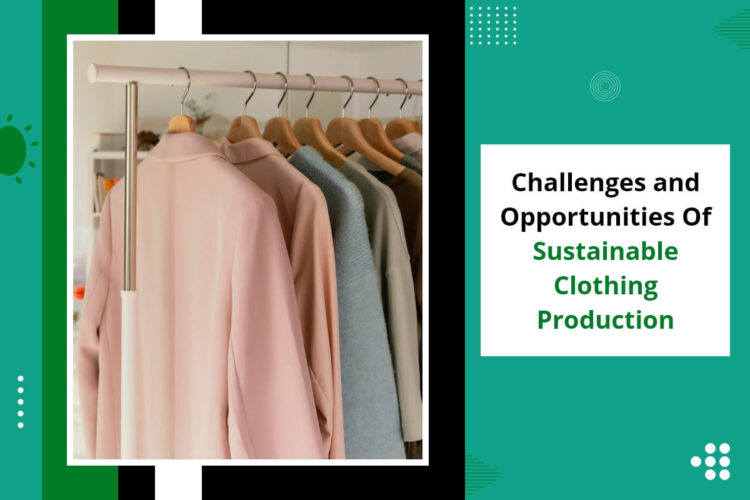As the fashion industry continues to grow, so makes the demand for sustainable clothing production. However, there are many challenges that garment manufacturers face when trying to produce clothing sustainably.
Here the blog takes a closer look at the challenges and opportunities of sustainable clothing production and how it can benefit both the consumer and the environment.
Challenges Of Sustainable Clothing Production
To meet the challenges of sustainable clothing production, the fashion industry must adopt new technologies and processes that reduce the environmental impact of clothing production. The most critical challenge is to reduce the use of hazardous chemicals in textile production. Other challenges include reducing water and energy consumption, minimizing waste, and reducing greenhouse gas emissions.
The fashion industry has made significant progress in adopting more sustainable practices in recent years, but there is still much room for improvement. One of the biggest challenges faced by sustainable fashion industry is reducing its reliance on hazardous chemicals.
These chemicals are used in various textile processes, from dyeing and finishing to printing and embroidery. They can have harmful effects on both workers and the environment.
Another challenge is to reduce water and energy consumption in clothing production. Water is used extensively in textile manufacturing, and it takes a lot of energy to power the machines that process fabrics.
In addition, garment factories often generate a lot of waste material, which can end up in landfill sites. To address these challenges, fashion companies like The Odd Factory are developing more efficient manufacturing processes and using renewable energy sources.
Opportunities For Sustainable Clothing Production
The clothing industry is one of the most polluting industries in the world. Every year, billions of garments are produced and sold, most made from synthetic fabrics like polyester and nylon. These materials are derived from petroleum, a non-renewable resource, and they release harmful chemicals into the environment during production and when worn and washed.
Fortunately, there are many opportunities for sustainable clothing manufacturing. More and more brands are using sustainable materials like organic cotton and bamboo. These materials are grown without harmful chemicals and are biodegradable, so they don\’t damage the environment when worn and washed.
Additionally, sustainable materials can often be sourced locally, which reduces transportation emissions.
These efforts make a difference in the fashion industry\’s environmental impact. But there\’s still more work to be done to make clothing production genuinely sustainable. They must continue searching for innovative solutions that reduce their reliance on harmful materials and processes. With the right strategies, people can create a more sustainable future for fashion.
Benefits Of Sustainable Clothing Production
There are many benefits of sustainable clothing production, including reducing environmental impact, improving working conditions, and supporting local economies. Sustainable clothing production often uses less water and energy than conventional methods and produces less pollution. It can also create jobs in the local community and support small-scale farmers and producers.
Sustainable clothing is often made from natural or recycled materials that are better for the environment than synthetic fabrics. It is also generally more durable than fast fashion garments, so it will last longer and save you money in the long run.
Most importantly, sustainable clothing production is about creating a system that works for people and the planet. When done right, it can help you move towards a more just and sustainable future for all.
Techniques For Reducing Environmental Impact In Manufacturing
There are some ways to reduce the environmental impact of clothing production, including:
Using sustainable materials: This includes using natural fibers such as organic cotton, linen, and wool; recycled materials such as recycled polyester; and other sustainable materials such as bamboo and hemp.
Implementing green manufacturing processes: This can involve using less water and energy in the manufacturing process and using eco-friendly methods such as dyeing with plant-based dyes or using lasers instead of chemicals for finishes and washing.
Reducing waste: Garment manufacturers in Mumbai can ensure that fabric scraps are reused or recycled and minimize packaging waste.
Supporting fair labor practices: This includes ensuring that workers are paid a living wage and working to improve conditions in the factories where clothing is produced.
Educating consumers: This means raising awareness about the impact of their clothing choices and encouraging them to buy from brands committed to sustainability.
Sustainable Clothing Manufacturing
The clothing industry is one of the most polluting industries in the world. The production of clothes uses a lot of energy and water and generates a lot of pollution. Making clothes also creates a lot of waste. Every year, billions of pounds of clothes are thrown away. The good news is that there are ways to make clothing production more sustainable.
Some companies, like The Odd Factory, are working on making sustainable clothing. They are using new technologies and materials to make more environmentally friendly clothing.
There are some challenges to making sustainable clothing. One challenge is the cost. Sustainable clothing manufacturing can be more expensive than traditional clothing. Another challenge is finding enough people who are willing to buy sustainable clothing.
But as more and more people become aware of the environmental impact of the clothing industry, demand for sustainable clothing will likely increase. If you are interested in buying sustainable clothing, you can look for labels that say the item is made from sustainable materials.
Conclusion
In conclusion, the opportunities that sustainable fashion production offers are numerous and varied. It provides an opportunity to reduce waste and promote ethical labor practices while creating jobs and promoting economic growth through responsible manufacturing.
With careful consideration of these unique challenges and opportunities, clothing manufacturers for startups in Melbourne like The Odd Factory can create a thriving business that meets its sustainability goals while still providing quality garments to its customers.
Investing in research and development around sustainable materials, design processes, and production techniques can ensure their business\’s prosperous future while minimizing potential adverse environmental impacts.



